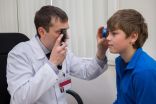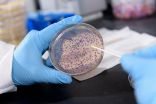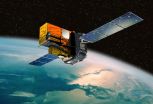(Press-News.org) The neutrino and its antimatter cousin, the antineutrino, are the tiniest subatomic particles known to science. These particles are byproducts of nuclear reactions within stars (including our sun), supernovae, black holes and human-made nuclear reactors. They also result from radioactive decay processes deep within the Earth, where radioactive heat and the heat left over from the planet's formation fuels plate tectonics, volcanoes and Earth's magnetic field.
Now, a team of geologists and physicists has generated the world's first global map of antineutrino emissions. The map, published online in the journal Scientific Reports on September 1, 2015, provides an important baseline image of the energy budget of Earth's interior and could help scientists monitor new and existing human-made sources of radiation. The study was led by the National Geospatial-Intelligence Agency with contributions from researchers at the University of Maryland, the University of Hawaii, Hawaii Pacific University and Ultralytics, LLC.
"The interior of Earth is quite difficult to see, even with modern technology. Locating the activity of antineutrinos allows us to create images that our predecessors had only dreamed of," said William McDonough, professor of geology at UMD and a co-author of the study. "This map should prove particularly useful for future studies of processes within the lower crust and mantle."
Neutrinos are notoriously difficult to study; their tiny size and lack of electrical charge enables them to pass straight through matter without reacting. At any given moment, trillions of neutrinos are passing through every structure and living thing on Earth. Luckily, antineutrinos are slightly easier to detect, through a process known as inverse beta decay. Spotting these reactions requires a huge detector the size of a small office building, housed about a mile underground to shield it from cosmic rays that could yield false positive results.
In the current study, the team analyzed data collected from two such detectors--one in Italy and one in Japan--to generate a picture of antineutrino emissions from natural sources deep within Earth. They combined this with data collected by the International Atomic Energy Agency (IAEA) on more than 400 operational nuclear reactors. In total, antineutrinos from these human-made sources accounted for less than 1 percent of the total detected.
"Keeping tabs on nuclear reactors is important for international safety and security. But as a geologist, I'm particularly excited for the potential to learn more about Earth's interior," McDonough said. "This project will allow us to access basic information about the planet's fuel budget across geologic time scales, and might yet reveal new and exciting details on the structure of the deep Earth."
The team plans to make periodic updates to the global antineutrino map in the future, with the help of improved models of Earth's interior and enhanced antineutrino detection technology. Updates to the map will also reflect the construction and decommission of nuclear reactors as appropriate. All told, the maps will provide an up-to-date picture of Earth's overall radioactivity.
"Antineutrinos are only one particle produced by Earth's natural radiation," explained Shawn Usman, R&D Scientist at the National Geospatial-Intelligence Agency and lead author of the study. "The National Geospatial-Intelligence Agency is working with UMD to develop additional radiation maps to characterize the Earth's naturally-occurring gamma and neutron radiation."
INFORMATION:
This research was supported by the National Geospatial-Intelligence Agency, the National Science Foundation (Award Nos. EAR 1068097 and EAR 1067983), and the U.S. Department of Energy. The content of this article does not necessarily reflect the views of these organizations.
The research paper, "AGM2015: Antineutrino Global Map 2015," Shawn Usman, Glenn Jocher, Stephen Dye, William McDonough and John Learned, was published online September 1, 2015 in the journal Scientific Reports.
Media Relations Contact: Matthew Wright, 301-405-9267, mewright@umd.edu
University of Maryland
College of Computer, Mathematical, and Natural Sciences
2300 Symons Hall
College Park, MD 20742
http://www.cmns.umd.edu
@UMDscience
About the College of Computer, Mathematical, and Natural Sciences
The College of Computer, Mathematical, and Natural Sciences at the University of Maryland educates more than 7,000 future scientific leaders in its undergraduate and graduate programs each year. The college's 10 departments and more than a dozen interdisciplinary research centers foster scientific discovery with annual sponsored research funding exceeding $150 million.
A new study has found that the occurrence of advanced forms of a diabetic eye disease remains low among children living with diabetes, regardless of how long they have had the disease or their ability to keep blood sugar levels controlled. Researchers are therefore recommending that most children with type 1 diabetes delay annual diabetic retinopathy screenings until age 15, or 5 years after their diabetes diagnosis, whichever occurs later. Their findings were published online today in Ophthalmology, the journal of the American Academy of Ophthalmology.
It is well established ...
A bacterium engineered to produce different pigments in response to varying levels of a micronutrient in blood samples could give health officials an inexpensive way to detect nutritional deficiencies in resource-limited areas of the world. This "bacterial litmus test," which currently measures levels of zinc, would require no electrical equipment and make results visible as simple color changes.
More than a billion people worldwide may be at risk for adequate zinc intake, but measuring zinc levels in blood samples currently requires sophisticated testing equipment not ...
In the "NeverEnding Story", Bastian feels so involved in the narration that he experiences the same emotions as the characters (and in the end he really enters the book). What happens to the main character of Micheal Ende's book is exactly what happens to each of us when we read a novel or a short story: we literally replicate the physiological processes and emotions of the characters described in the text. Francesco Foroni, research scientist at the International School for Advanced Studies (SISSA) of Trieste, already demonstrated this phenomenon a few years ago in a study ...
PULLMAN, Wash.--Washington State University researchers have found that the timing of an animal's sleep can be just as important as how much sleeps it gets.
Ilia Karatsoreos, an assistant professor in WSU's Department of Integrative Physiology and Neuroscience, shifted mice from their usual cycle of sleeping and waking and saw that, while they got enough sleep, it was of poorer quality. The animals also had a disrupted immune response, leaving them more open to illness.
Most sleep research focuses on the effects of sleep deprivation or the overall amount of sleep an animal ...
A multi-disciplinary group of European researchers spanning natural science, socio-economics and law have joined forces to assess the current landscape of deep-sea research and investment in Europe. Once considered remote and inaccessible, commercial interest to exploit the deep sea (1) is rising due to economic drivers and technology developments. However, exploitation activities in the deep sea remain highly contentious, particularly regarding the potential risks and environmental impacts associated with such activities. A consultation of deep-sea stakeholders spanning ...
New research from LSTM has revealed precisely how insecticide-treated bed nets are so effective against malaria mosquitoes.
Communities in the poorest countries are the most vulnerable to malaria and 90% of all malaria deaths occur in Africa. Safe, simple and affordable, long-lasting insecticidal bed nets (LLINs) are very effective in preventing malaria and have played a major part in reducing malaria deaths in Africa by over 50% since 2000 (WHO). However, as very little is known about how mosquitoes interact with nets or how LLINs do their job so effectively, how they ...
Researchers at University of La Rioja (Spain) have developed a new method to eliminate artificial satellites in Highly Elliptical Orbits when they finish their mission. The methodology, which allows for a reduction of both cost and risk, has been tested with the European Space Agency INTEGRAL mission, which will re-enter into the Earth's atmosphere in order to disintegrate in 2029.
The problem of space debris is one of the main challenges that aerospace engineers have to face, due to the danger it poses to satellites. In this context, members of the Scientific Computing ...
BEIJING, CHINA (1 September 2015)--At a time when the price of mutton is climbing and wool crashing, a groundbreaking new study has used advanced genetic sequencing technology to rewrite the history of sheep breeding and trading along the ancient Silk Road--insights that can help contemporary herders in developing countries preserve or recover valuable traits crucial to their food and economic security.
The new findings regarding one of the first animals ever domesticated will be published in the October print edition of the journal Molecular Biology and Evolution. They ...
DENVER (Sept. 1, 2015) - While many planners focus on the threat of natural disasters to major metropolises around the world, a new study from the University of Colorado Denver shows smaller cities are often even less equipped to handle such catastrophes.
"Small cities are often far away from where decisions get made and struggle to insert themselves into the agenda of decision-making bodies," said study author Andrew Rumbach, PhD, an assistant professor at the CU Denver College of Architecture and Planning, a major center of timely, topical and relevant research. "When ...
The unique properties found in the stunning iridescent wings of a tropical blue butterfly could hold the key to developing new highly selective gas detection sensors.
Pioneering new research by a team of international scientists, including researchers from the University of Exeter, has replicated the surface chemistry found in the iridescent scales of the Morpho butterfly to create an innovative gas sensor.
The ground-breaking findings could help inspire new designs for sensors that could be used in a range of sectors, including medical diagnostics, industry, and the ...


